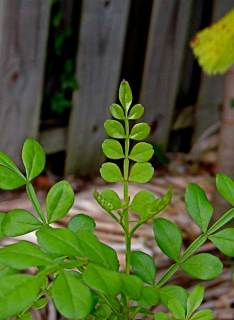One of the cornerstone plantings in my new backyard is a Wild Lime tree, Zanthoxylum fagara. It didn’t come from the native plant auction, but from one of my friends in the Audubon Society who is also an FNPS member and who graciously allowed me to come take many many plants to get my back yard started. Wild lime is a great one, because it’s useful in many ways: as a larval host plant for Giant Swallowtail butterflies, as a cover plant for small birds (it has thorns to deter predators, although because it’s a tree, it’s not as good as a thickety shrub would be), and, because of its aromatic leaves, as a nice accent tree in the native garden. Neither Craig Huegel (“The seeds have only very minor value to most wildlife”) nor Rufino Osorio (“It does not have any outstanding horticultural attributes…”) seem to like it too much, although they note that it is popular with butterfly gardeners.
I’m just glad that it’s coming in, as I had my doubts when I first planted it. It seemed to be taking forever to send up new growth. But some tender leaflets are appearing at last:
The entire plant is about two feet tall right now, and it looks like it’s rooting well, as the new growth is coming in nicely:
I’ve planted this member of the prickly ash family in an out-of-the-way corner of the yard, along with some other prickly plants like coral bean (Erythrina herbacea); as I get more plants I’m going to screen in front of it with marlberry, wild coffee, firebush, etc., so people don’t blunder into the thorns.
Etymology
Zanthoxylum means “yellow wood”; I’m not sure what Linnaeus meant by “fagara,” which is also the name of a genus of tree found in India.
Wild Lime is a citrus tree, but it bears only the tiniest of fruits, certainly nothing like a true lime or Key lime tree would… Nonetheless, I’m excited to have it in my garden!


